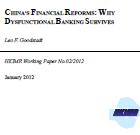China’s Financial Reforms: Why Dysfunctional Banking Survives
There is a growing consensus that China’s banking remains woefully dysfunctional despite almost 40 years of reforms. This paper explores why the government has found this situation both tolerable and affordable. Historically, the state has passed much of the heavy but indirect costs of economic modernisation on to the banks. Currently, the banks are virtually the last effective lever through which the leadership can impose its priorities on a fiscally decentralised state and increasingly market-driven economy. Thus, despite central bank and financial regulators’ calls for greater regard for commercial realities, state priorities and political intervention are likely to remain powerful influences on bank lending.
Click to read more.
